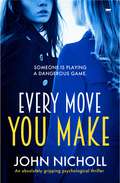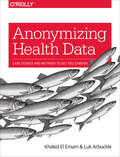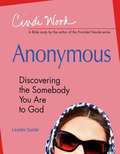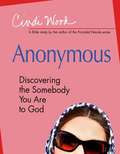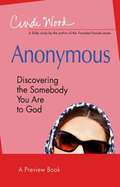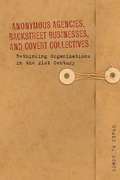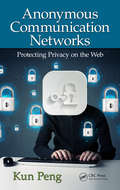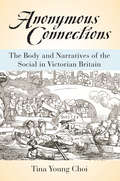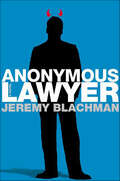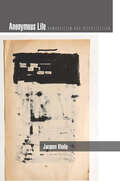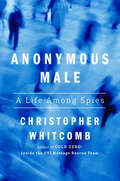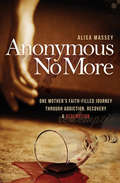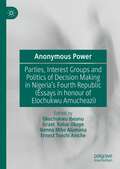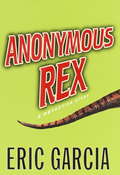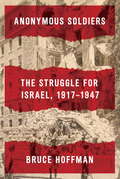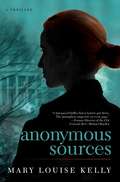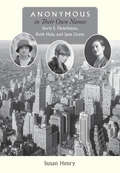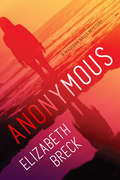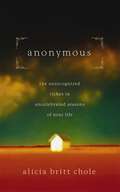- Table View
- List View
Anonymity: A Chilling Psychological Thriller (DI Gravel Books #4)
by John NichollAs a deranged stalker threatens a successful novelist, DI Gravel pursues a serial killer in this &“insidious and very creepy&” psychological thriller (Patricia Dixon, author of Over My Shoulder). As a successful novelist living in Wales, Mia is used to fans who occasionally crossed the line. But nothing so chilling as the untraceable email she received with the message &“I know where you live.&” And that was just the beginning. Unaware that the psychopath has placed cameras in her home, Mia soon receives intimate photos of herself and her four-year-old daughter. The messages demand that she performs outlandish tasks, threatening dire consequences if she refuses or approaches the police. As the pressure builds, Mia&’s sister's boyfriend offers to escort her safely to Italy where she can stay with her parents. But when their villa burns down, Mia fears that there may be no escape. Meanwhile, the police are investigating the murder of three women back in Wales, and when DI Gravel&’s daughter is threatened, he takes matters into his own hands
Anonymity: A Family Memoir
by Susan BergmanWhen Don Heche dies of AIDS in 1985, his wife and four children are left reeling in shock. How could this husband and father, a devoted member of the Baptist church and a gifted musician, have lived a secret life? Through a series of vignettes and personal reflections Susan Bergman describes her father, her family, and the insidious effects of secrecy. Ten years after her father's death she searches out people who knew him in his other life, and explores the painful legacy of secrecy he has left her. Bergman is the sister of actress Anne Heche.
Anonymity: A Secret History of English Literature
by John MullanSome of the greatest works in English literature were first published without their authors' names. Why did so many authors want to be anonymous--and what was it like to read their books without knowing for certain who had written them? In Anonymity, John Mullan gives a fascinating and original history of hidden identity in English literature. From the sixteenth century to today, he explores how the disguises of writers were first used and eventually penetrated, how anonymity teased readers and bamboozled critics--and how, when book reviews were also anonymous, reviewers played tricks of their own in return. Today we have forgotten that the first readers of Gulliver's Travels and Sense and Sensibility had to guess who their authors might be, and that writers like Sir Walter Scott and Charlotte Brontë went to elaborate lengths to keep secret their authorship of the best-selling books of their times. But, in fact, anonymity is everywhere in English literature. Spenser, Donne, Marvell, Defoe, Swift, Fanny Burney, Austen, Byron, Thackeray, Lewis Carroll, Tennyson, George Eliot, Sylvia Plath, and Doris Lessing--all hid their names. With great lucidity and wit, Anonymity tells the stories of these and many other writers, providing a fast-paced, entertaining, and informative tour through the history of English literature.
Anonymization (SpringerBriefs in Cybersecurity)
by Rolf H. Weber Ulrike I. HeinrichWithin the last decade, the Internet has developed as a phenomenon encompassing social, cultural, economic and legal facets. It has become common practice to use the Internet for both the retrieval and provision of information, with the result that the Internet has become a valuable tool in everyday life. Many Internet participants are unaware that they leave data tracks on every website they pass; surfing on the World Wide Web is far from being an anonymous activity of no consequence. In recent years a number of networking techniques have been initiated in order to accommodate the netizen's wish for anonymous communication and the protection of their privacy in the online world. Anonymization explores the legal framework developed to help protect netizens' privacy and their wish for anonymous communication over the Internet. It debates the value in helping to protect anonymity over a network which sees an increasing number of cybercrimes, and explores governmental interventions into anonymity requests, and whether requests should only be legal if a sufficiently legitimized public interest is given.
Anonymizing Health Data: Case Studies and Methods to Get You Started
by Luk Arbuckle Khaled El EmamUpdated as of August 2014, this practical book will demonstrate proven methods for anonymizing health data to help your organization share meaningful datasets, without exposing patient identity. Leading experts Khaled El Emam and Luk Arbuckle walk you through a risk-based methodology, using case studies from their efforts to de-identify hundreds of datasets.Clinical data is valuable for research and other types of analytics, but making it anonymous without compromising data quality is tricky. This book demonstrates techniques for handling different data types, based on the authors’ experiences with a maternal-child registry, inpatient discharge abstracts, health insurance claims, electronic medical record databases, and the World Trade Center disaster registry, among others.Understand different methods for working with cross-sectional and longitudinal datasetsAssess the risk of adversaries who attempt to re-identify patients in anonymized datasetsReduce the size and complexity of massive datasets without losing key information or jeopardizing privacyUse methods to anonymize unstructured free-form text dataMinimize the risks inherent in geospatial data, without omitting critical location-based health informationLook at ways to anonymize coding information in health dataLearn the challenge of anonymously linking related datasets
Anonymous - Women's Bible Study Leader Guide: Discovering the Somebody You Are to God (Anonymous)
by Cindi WoodAt one time or another, every woman has felt overlooked, unimportant, and bruised by the world. But there’s good news. While the opinion of others may drag us down, the God who created us has an entirely different opinion of who we are. That’s because we are His creations, and everything He created is good! Women today are searching for ways to make a difference in their daily lives. Whether they are working women, stay-at-home moms, or women moving into their retirement years, they all want to be a somebody who makes a positive impact in the world around them. The Bible is filled with "anonymous" women who made a significant impact in God’s story. Anonymous helps women discover their uniqueness and significance to Christ by exploring some of the "anonymous" women of the Bible. Though we do not know their names, they all were known and loved by God. Each week of this six-session study begins with an overview of the anonymous woman’s story, including background material with relevance to the cultural lifestyles and surroundings of the day. The daily lessons explore her story and the ways that all women can relate to her. Contemporary "anonymous" stories and quotes from everyday women are sprinkled throughout, reinforcing the very personal relevance of this powerful study. Together women will explore and grow in their relationship with Christ as they find their significance in the heart of God. The Leader Guide contains six session plan outlines, complete with discussion points and questions, activities, prayers, and more—plus leader helps for facilitating a group. Other available components, each available separately, include a Participant Workbook with five days of lessons per week, DVD with six 20-25 minute sessions (with closed captioning), and boxed Leader Kit containing one of each component.
Anonymous - Women's Bible Study Participant Book: Discovering the Somebody You Are to God (Anonymous)
by Cindi WoodAt one time or another, every woman has felt overlooked, unimportant, and bruised by the world. But there’s good news. While the opinion of others may drag us down, the God who created us has an entirely different opinion of who we are. That’s because we are His creations, and everything He created is good! Women today are searching for ways to make a difference in their daily lives. Whether they are working women, stay-at-home moms, or women moving into their retirement years, they all want to be a somebody who makes a positive impact in the world around them. The Bible is filled with "anonymous" women who made a significant impact in God’s story. Anonymous helps women discover their uniqueness and significance to Christ by exploring some of the "anonymous" women of the Bible. Though we do not know their names, they all were known and loved by God. Each week of this six-session study begins with an overview of the anonymous woman’s story, including background material with relevance to the cultural lifestyles and surroundings of the day. The daily lessons explore her story and the ways that all women can relate to her. Contemporary "anonymous" stories and quotes from everyday women are sprinkled throughout, reinforcing the very personal relevance of this powerful study. Together women will explore and grow in their relationship with Christ as they find their significance in the heart of God. The participant workbook includes 5 lessons for each week with space for recording reflections and answers. Other components for the Bible study, available separately, include a Leader's Guide, DVD with six 24-29 minute sessions, and boxed Leader Kit (an all-inclusive box containing one copy of each of the Bible study’s components).
Anonymous - Women's Bible Study Preview Book: Discovering the Somebody You Are to God
by Cindi WoodThis pocket-size book provides a snapshot of some of the "anonymous" women of the Bible who made a significant impact in God’s story. Based on the Bible study Anonymous: Discovering the Somebody You Are to God.
Anonymous Agencies, Backstreet Businesses, and Covert Collectives: Rethinking Organizations in the 21st Century
by Craig R. ScottMany of today's organizations "live in public"; they devote extensive resources to branding, catching the public eye, and capitalizing on the age of transparency. But, at the same time, a growing number of companies and other collectives are flying under the radar, concealing their identities and activities. This book offers a framework for thinking about how organizations and their members communicate identity to relevant audiences. Considering the degree to which organizations reveal themselves, the extent to which members express their identification with the organization, and whether the audience is public or local, author Craig R. Scott describes collectives as residing in "regions" that range from transparent to shaded, from shadowed to dark. Taking a closer look at groups like EarthFirst!, the Church of Scientology, Alcoholics Anonymous, the KKK, Skull and Bones, U.S. special mission units, men's bathhouses, and various terrorist organizations, this book draws attention to shaded, shadowed, and dark collectives as important organizations in the contemporary landscape.
Anonymous Communication Networks: Protecting Privacy on the Web
by Kun PengIn today's interactive network environment, where various types of organizations are eager to monitor and track Internet use, anonymity is one of the most powerful resources available to counterbalance the threat of unknown spectators and to ensure Internet privacy.Addressing the demand for authoritative information on anonymous Internet usage, Ano
Anonymous Connections: The Body and Narratives of the Social in Victorian Britain
by Tina Young ChoiAnonymous Connections asks how the Victorians understood the ethical, epistemological, and biological implications of social belonging and participation. Specifically, Tina Choi considers the ways nineteenth-century journalists, novelists, medical writers, and social reformers took advantage of spatial frames-of-reference in a social landscape transforming due to intense urbanization and expansion. New modes of transportation, shifting urban demographics, and the threat of epidemics emerged during this period as anonymous and involuntary forms of contact between unseen multitudes. While previous work on the early Victorian social body have tended to describe the nineteenth-century social sphere in static political and class terms, Choi's work charts new critical terrain, redirecting attention to the productive--and unpredictable--spaces between individual bodies as well as to the new narrative forms that emerged to represent them. Anonymous Connections makes a significant contribution to scholarship on nineteenth-century literature and British cultural and medical history while offering a timely examination of the historical forebears to modern concerns about the cultural and political impact of globalization.
Anonymous Lawyer: A Novel
by Jeremy BlachmanA wickedly funny debut novel about a high-powered lawyer whose shockingly candid blog about life inside his firm threatens to destroy himHe's a hiring partner at one of the world's largest law firms. Brilliant yet ruthless, he has little patience for associates who leave the office before midnight or steal candy from the bowl on his secretary's desk. He hates holidays and paralegals. And he's just started a weblog to tell the world about what life is really like at the top of his profession.Meet Anonymous Lawyer—corner office, granite desk, and a billable rate of $675 an hour. The summer is about to start, and he's got a new crop of law school interns who will soon sign away their lives for a six-figure salary at the firm. But he's also got a few problems that require his attention. There's The Jerk, his bitter rival at the firm, who is determined to do whatever it takes to beat him out for the chairman's job. There's Anonymous Wife, who is spending his money as fast as he can make it. And there's that secret blog he's writing, which is a perverse bit of fun until he gets an e-mail from someone inside the firm who knows he's its author.Written in the form of a blog, Anonymous Lawyer is a spectacularly entertaining debut that rips away the bland façade of corporate law and offers a telling glimpse inside a frightening world. Hilarious and fiendishly clever, Jeremy Blachman's tale of a lawyer who lives a lie and posts the truth is sure to be one of the year's most talked-about novels.
Anonymous Life: Romanticism and Dispossession
by Jacques KhalipRomanticism is often synonymous with models of identity and action that privilege individual empowerment and emotional autonomy. In the last two decades, these models have been the focus of critiques of Romanticism's purported self-absorption and alienation from politics. While such critiques have proven useful, they often draw attention to the conceptual or material tensions of romantic subjectivity while accepting a conspicuous, autonomous subject as a given, thus failing to appreciate the possibility that Romanticism sustains an alternative model of being, one anonymous and dispossessed, one whose authority is irreducible to that of an easily recognizable, psychologized persona. In Anonymous Life, Khalip goes against the grain of these dominant critical stances by examining anonymity as a model of being that is provocative for writers of the era because it resists the Enlightenment emphasis on transparency and self-disclosure. He explores how romantic subjectivity, even as it negotiates with others in the social sphere, frequently rejects the demands of self-assertion and fails to prove its authenticity and coherence.
Anonymous Male: A Life Among Spies
by Christopher WhitcombA no-holds-barred memoir about identity, from a former Hostage Rescue Team sniper who left the FBI on 9/11 only to lose himself, moving deeper into a world of spies. In September 2001, Christopher Whitcomb was the most visible FBI agent in the world. His bestselling memoir, Cold Zero, had led to novels, articles in GQ, and op-eds in The New York Times. He appeared on Imus in the Morning, Larry King, and Meet the Press; he was nominated for a Peabody reporting for CNBC. He played poker with Brad Pitt while contracting for the CIA. Then one day in 2006, without warning, Whitcomb packed a bag, flew into Somalia, and dropped off the face of the earth. For fifteen years, he waged a mercenary war on himself, traveling the world with aliases, cash, and guns. He built a private army in the jungles of Timor-Leste, working contracts for intelligence agencies, where he survived a coup d&’état only to lose his friends, abandon his family, and give up on God.And though many stories might have ended there, Anonymous Male is a tale of redemption. While surfing the wilds of Indonesia, Whitcomb found himself trapped beneath a giant wave, where, at the edge of drowning, he came to terms with the chaos of his own clandestine life. He survived the wave to find his way home and rebuild the world that he had abandoned. Anonymous Male is a riveting memoir about loss and recovery, a deeply intimate story that spans continents, war, politics and the media. It is a confession, and a cautionary tale of what happens to people whom the government trains to lie, even to themselves.
Anonymous No More: One Mother's Faith-Filled Journey Through Addiction, Recovery & Redemption
by Alisa MasseyThe inspiring, heartfelt story of one mother&’s faith-filled journey through addiction and recovery . . . to finally find redemption in God&’s grace. Alcohol and drugs took away what mattered most in this mother&’s life . . . and a once promising future came to an abrupt halt as her addiction forced her into seclusion. Although she hoped to escape the entrapment of her drug dependence, the road to sobriety seemed full of unexpected road blocks and dead ends. Her situation seemed inescapable, but she would ultimately find the one true way to escape—and that way would supply her with everlasting life. Before the dangerous habits could do her in, her cry for help was heard and God placed this woman in the perfect hands so she could learn to live again. Discovering her identity in Christ, she became anonymous no more.
Anonymous Power: Parties, Interest Groups and Politics of Decision Making in Nigeria’s Fourth Republic (Essays in Honour of Elochukwu Amucheazi)
by Ikenna Mike Alumona Ernest Toochi Aniche Okechukwu Ibeanu Israel ‘Kelue OkoyeThis book examines the structures and processes of political decision-making and governance in Nigeria. Since Nigeria returned to elected government in 1999, it has been observed that several factors account for the differences between the design of statutory structures and processes of political decision-making and how they operate in reality. In other words, there are wide gaps between statutes and practice of political decision-making. However, the nexus between the two remains largely understudied by political scientists. Instinctively, political scientists assume that informal influences in political decision-making are aberrations, episodic or temporary.This book is designed to interrogate the nexus between the formal and non-formal dimensions of the dynamics of political decision making in Nigeria and also provide evidence about the actual functioning of governmental structures in Nigeria. The thesis of the book is that the non-formal dimension of political decision making as evidenced in rising ethno-political patronages, religious sentiments, clientelism and factionalism, are interacting with formal decision-making structures in ways that largely undermine the latter and, by extension, the democratic system. The book pursues this thesis by examining the roles of actors and institutions including, electoral choices made by voters, legislations, which perhaps is the most fundamental form of political decision-making, policies made by the executive and administration, as well as decision making within political parties, since parties are sites for articulating and aggregating issues on which decisions are to be made.
Anonymous Rex: A Detective Story
by Eric Garcia"What would the world be like if the dinosaurs hadn't gone extinct? As this very funny book shows, for one thing, L.A. would be even weirder than it is now." --Dave BarryVincent Rubio, a Los Angeles private investigator, is down on his luck: He's out of work. His car's been repossessed. His partner has died under mysterious circumstances. And his tail just won't stay put. Vincent is a dinosaur--a Velociraptor, to be precise. It seems the dinosaurs faked their extinction 65 million years ago and still roam the earth, disguised in convincing latex costumes that help them blend perfectly into human society. A heightened sense of smell allows the dinos to detect one another--Vincent's got an odor like a tasty Cuban cigar.When Vincent is called to investigate a two-bit case of arson at a hip dino nightclub, he discovers something much more sinister, which lures him back to New York City--the scene of his partner's death and a dangerous nexus of dinosaur and human intermingling. Will Vincent solve the mystery of his partner's death? Will a gorgeous blond chanteuse discover his true identity, jeopardizing both their lives? Will Vincent be able to conquer his dangerous addiction to basil, or will he wind up in Herba-holics Anonymous? Will he find true love, or resort to crumpled issues of Stegolicious? Somewhere between Jurassic Park and L.A. Confidential lies Eric Garcia's Anonymous Rex, one of the smartest, wittiest, and most entertaining debuts this side of the Ice Age.
Anonymous Rex: A Detective Story
by Eric Garcia"What would the world be like if the dinosaurs hadn't gone extinct? As this very funny book shows, for one thing, L.A. would be even weirder than it is now." --Dave BarryVincent Rubio, a Los Angeles private investigator, is down on his luck: He's out of work. His car's been repossessed. His partner has died under mysterious circumstances. And his tail just won't stay put. Vincent is a dinosaur--a Velociraptor, to be precise. It seems the dinosaurs faked their extinction 65 million years ago and still roam the earth, disguised in convincing latex costumes that help them blend perfectly into human society. A heightened sense of smell allows the dinos to detect one another--Vincent's got an odor like a tasty Cuban cigar.When Vincent is called to investigate a two-bit case of arson at a hip dino nightclub, he discovers something much more sinister, which lures him back to New York City--the scene of his partner's death and a dangerous nexus of dinosaur and human intermingling. Will Vincent solve the mystery of his partner's death? Will a gorgeous blond chanteuse discover his true identity, jeopardizing both their lives? Will Vincent be able to conquer his dangerous addiction to basil, or will he wind up in Herba-holics Anonymous? Will he find true love, or resort to crumpled issues of Stegolicious? Somewhere between Jurassic Park and L.A. Confidential lies Eric Garcia's Anonymous Rex, one of the smartest, wittiest, and most entertaining debuts this side of the Ice Age.
Anonymous Soldiers
by Bruce HoffmanA landmark history, based on newly available documents, of the battles between Jews, Arabs, and the British that led to the creation of IsraelAnonymous Soldiers brilliantly re-creates the crucial period in the establishment of Israel, chronicling the three decades of growing anticolonial unrest that culminated in the end of British rule and the UN resolution to create two separate states. This groundbreaking book tells in riveting, previously unknown detail the story of how Britain, in the twilight of empire, struggled and ultimately failed to reconcile competing Arab and Jewish demands and uprisings. Bruce Hoffman, America's leading expert on terrorism, shines new light on the bombing of the King David Hotel, the assassination of Lord Moyne in Cairo, the leadership of Menachem Begin, the life and death of Abraham Stern, and much else. Above all, Hoffman shows exactly how the underdog "anonymous soldiers" of Irgun and Lehi defeated the British and set in motion the chain of events that resulted in the creation of the formidable nation-state of Israel. This is a towering accomplishment of research and narrative, and a book that is essential to anyone wishing to understand not just the origins of modern-day Israel or the current situation in the Middle East, but also the methodology of terrorism. Drawing on previously untapped archival resources in London, Washington, D.C., and Jerusalem, Bruce Hoffman has written one of the most detailed and sustained accounts of a terrorist and counterterrorist campaign that may ever have been seen, and in doing so has cast light on one of the most decisive world events in recent history. This will be the definitive account of the struggle for Israel for years to come.From the Hardcover edition.
Anonymous Sources
by Mary Louise KellyAn intriguing thriller from a former NPR correspondent about a young reporter who must match wits with spies, assassins and a terrorist sleeper cell targeting the very heart of American power.Thom Carlyle had it all: the rowing trophies, the Oxbridge education, the glamorous girlfriend. But on a glorious summer evening in Harvard Square, Thom is murdered--pushed from the top of a Harvard bell tower. The New England Chronicle sends a beautiful, feisty, but troubled reporter named Alexandra James to investigate. It is the story of a lifetime. But it is not what it seems. Alex's reporting takes her abroad, from the cobbled courtyards of Cambridge, England...to the inside of a network of nuclear terrorists...to the corridors of the CIA...and finally, to the terrorists' target itself.
Anonymous in Their Own Names: Doris E. Fleischman, Ruth Hale, and Jane Grant
by Susan HenryAnonymous in Their Own Names recounts the lives of three women who, while working as their husbands' uncredited professional partners, had a profound and enduring impact on the media in the first half of the twentieth century. With her husband, Edward L. Bernays, Doris E. Fleischman helped found and form the field of public relations. Ruth Hale helped her husband, Heywood Broun, become one of the most popular and influential newspaper columnists of the 1920s and 1930s. In 1925 Jane Grant and her husband, Harold Ross, started the New Yorker magazine.Yet these women's achievements have been invisible to countless authors who have written about their husbands. This invisibility is especially ironic given that all three were feminists who kept their birth names when they married as a sign of their equality with their husbands, then battled the government and societal norms to retain their names. Hale and Grant so believed in this cause that in 1921 they founded the Lucy Stone League to help other women keep their names, and Grant and Fleischman revived the league in 1950. This was the same year Grant and her second husband, William Harris, founded White Flower Farm, pioneering at that time and today one of the country's most celebrated commercial nurseries.Despite strikingly different personalities, the three women were friends and lived in overlapping, immensely stimulating New York City circles. Susan Henry explores their pivotal roles in their husbands' extraordinary success and much more, including their problematic marriages and their strategies for overcoming barriers that thwarted many of their contemporaries.
Anonymous in Their Own Names: Doris E. Fleischman, Ruth Hale, and Jane Grant
by Susan HenryAnonymous in Their Own Names recounts the lives of three women who, while working as their husbands' uncredited professional partners, had a profound and enduring impact on the media in the first half of the twentieth century. With her husband, Edward L. Bernays, Doris E. Fleischman helped found and form the field of public relations. Ruth Hale helped her husband, Heywood Broun, become one of the most popular and influential newspaper columnists of the 1920s and 1930s. In 1925 Jane Grant and her husband, Harold Ross, started the New Yorker magazine. Yet these women's achievements have been invisible to countless authors who have written about their husbands. This invisibility is especially ironic given that all three were feminists who kept their birth names when they married as a sign of their equality with their husbands, then battled the government and societal norms to retain their names. Hale and Grant so believed in this cause that in 1921 they founded the Lucy Stone League to help other women keep their names, and Grant and Fleischman revived the league in 1950. This was the same year Grant and her second husband, William Harris, founded White Flower Farm, pioneering at that time and today one of the country's most celebrated commercial nurseries. Despite strikingly different personalities, the three women were friends and lived in overlapping, immensely stimulating New York City circles. Susan Henry explores their pivotal roles in their husbands' extraordinary success and much more, including their problematic marriages and their strategies for overcoming barriers that thwarted many of their contemporaries.
Anonymous: A Madison Kelly Mystery (A Madison Kelly Mystery #1)
by Elizabeth BreckThe note was threatening enough--but its link to two cold cases and a sinister unseen presence sends P.I. Madison Kelly on a frantic search for the truth.Madison Kelly, a San Diego private investigator, arrives home to a note stabbed to her front door: Stop investigating me, or I will hunt you down and kill you. The only problem? Madison hasn't been investigating anyone--she's been taking time off to figure out what to do with her life. But how does she prove a negative? The only way to remove the threat is to do exactly what "Anonymous", the note writer, is telling her not to do: investigate to see who left it. Could this have something to do with the true crime podcast she's been tweeting about, and the missing girls?The girls went missing, two years apart, after a night at the clubs in San Diego's famed Gaslamp Quarter, and Madison had been probing the internet for clues. She discovers that someone has been one step ahead of her, monitoring her tweets to prevent her from getting too close. Soon Madison's investigation brings up more questions than answers: are the disappearances connected? Are the girls dead or did they just walk away from their lives? And who is Anonymous, the person who will stop at nothing to keep Madison from learning the truth?As she closes in, so does Anonymous. Set against a backdrop of surfer culture and coffee houses of San Diego, Anonymous follows Madison as she confronts the reality of the girls' disappearance in a terrifying climax where the hunter becomes the hunted--and Madison is running for her life.
Anonymous: Jesus' hidden years...and yours
by Alicia Britt CholeWe all experience times of hiddenness, when our potential is unseen and our abilities unapplauded. This book redeems those times by reminding us that though we often want to rush through these anonymous seasons of the soul, they hold enormous power to cultivate character traits that cannot be developed any other way!
